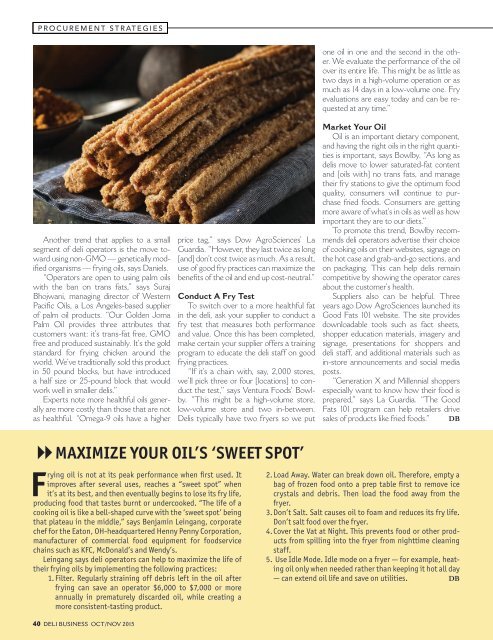DELI BUSINESS
1iADwm7
1iADwm7
Create successful ePaper yourself
Turn your PDF publications into a flip-book with our unique Google optimized e-Paper software.
PROCUREMENT STRATEGIES<br />
Another trend that applies to a small<br />
segment of deli operators is the move toward<br />
using non-GMO — genetically modified<br />
organisms — frying oils, says Daniels.<br />
“Operators are open to using palm oils<br />
with the ban on trans fats,” says Suraj<br />
Bhojwani, managing director of Western<br />
Pacific Oils, a Los Angeles-based supplier<br />
of palm oil products. “Our Golden Joma<br />
Palm Oil provides three attributes that<br />
customers want: it’s trans-fat free, GMO<br />
free and produced sustainably. It’s the gold<br />
standard for frying chicken around the<br />
world. We’ve traditionally sold this product<br />
in 50 pound blocks, but have introduced<br />
a half size or 25-pound block that would<br />
work well in smaller delis.”<br />
Experts note more healthful oils generally<br />
are more costly than those that are not<br />
as healthful. “Omega-9 oils have a higher<br />
price tag,” says Dow AgroSciences’ La<br />
Guardia. “However, they last twice as long<br />
[and] don’t cost twice as much. As a result,<br />
use of good fry practices can maximize the<br />
benefits of the oil and end up cost-neutral.”<br />
Conduct A Fry Test<br />
To switch over to a more healthful fat<br />
in the deli, ask your supplier to conduct a<br />
fry test that measures both performance<br />
and value. Once this has been completed,<br />
make certain your supplier offers a training<br />
program to educate the deli staff on good<br />
frying practices.<br />
“If it’s a chain with, say, 2,000 stores,<br />
we’ll pick three or four [locations] to conduct<br />
the test,” says Ventura Foods’ Bowlby.<br />
“This might be a high-volume store,<br />
low-volume store and two in-between.<br />
Delis typically have two fryers so we put<br />
one oil in one and the second in the other.<br />
We evaluate the performance of the oil<br />
over its entire life. This might be as little as<br />
two days in a high-volume operation or as<br />
much as 14 days in a low-volume one. Fry<br />
evaluations are easy today and can be requested<br />
at any time.”<br />
Market Your Oil<br />
Oil is an important dietary component,<br />
and having the right oils in the right quantities<br />
is important, says Bowlby. “As long as<br />
delis move to lower saturated-fat content<br />
and [oils with] no trans fats, and manage<br />
their fry stations to give the optimum food<br />
quality, consumers will continue to purchase<br />
fried foods. Consumers are getting<br />
more aware of what’s in oils as well as how<br />
important they are to our diets.”<br />
To promote this trend, Bowlby recommends<br />
deli operators advertise their choice<br />
of cooking oils on their websites, signage on<br />
the hot case and grab-and-go sections, and<br />
on packaging. This can help delis remain<br />
competitive by showing the operator cares<br />
about the customer’s health.<br />
Suppliers also can be helpful. Three<br />
years ago Dow AgroSciences launched its<br />
Good Fats 101 website. The site provides<br />
downloadable tools such as fact sheets,<br />
shopper education materials, imagery and<br />
signage, presentations for shoppers and<br />
deli staff, and additional materials such as<br />
in-store announcements and social media<br />
posts.<br />
“Generation X and Millennial shoppers<br />
especially want to know how their food is<br />
prepared,” says La Guardia. “The Good<br />
Fats 101 program can help retailers drive<br />
sales of products like fried foods.” DB<br />
MAXIMIZE YOUR OIL’S ‘SWEET SPOT’<br />
Frying oil is not at its peak performance when first used. It<br />
improves after several uses, reaches a “sweet spot” when<br />
it’s at its best, and then eventually begins to lose its fry life,<br />
producing food that tastes burnt or undercooked. “The life of a<br />
cooking oil is like a bell-shaped curve with the ‘sweet spot’ being<br />
that plateau in the middle,” says Benjamin Leingang, corporate<br />
chef for the Eaton, OH-headquartered Henny Penny Corporation,<br />
manufacturer of commercial food equipment for foodservice<br />
chains such as KFC, McDonald’s and Wendy’s.<br />
Leingang says deli operators can help to maximize the life of<br />
their frying oils by implementing the following practices:<br />
1. Filter. Regularly straining off debris left in the oil after<br />
frying can save an operator $6,000 to $7,000 or more<br />
annually in prematurely discarded oil, while creating a<br />
more consistent-tasting product.<br />
2. Load Away. Water can break down oil. Therefore, empty a<br />
bag of frozen food onto a prep table first to remove ice<br />
crystals and debris. Then load the food away from the<br />
fryer.<br />
3. Don’t Salt. Salt causes oil to foam and reduces its fry life.<br />
Don’t salt food over the fryer.<br />
4. Cover the Vat at Night. This prevents food or other products<br />
from spilling into the fryer from nighttime cleaning<br />
staff.<br />
5. Use Idle Mode. Idle mode on a fryer — for example, heating<br />
oil only when needed rather than keeping it hot all day<br />
— can extend oil life and save on utilities. DB<br />
40 <strong>DELI</strong> <strong>BUSINESS</strong> OCT/NOV 2015


